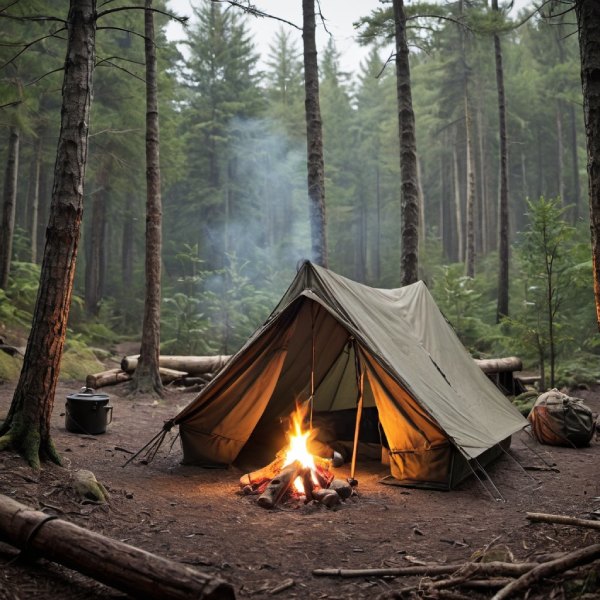Mastering the Art of Setting Up a Survival Camp: A Comprehensive Guide
Survival camping is an exhilarating adventure that reconnects us with nature’s raw beauty while testing our skills and resilience. Whether you’re an experienced outdoorsman or a novice adventurer, establishing a well-prepared survival camp is paramount for ensuring a safe and enjoyable experience. In this guide, we’ll delve into the intricacies of setting up a survival camp, covering essential aspects such as tent placement, hazard awareness, selecting a serene location, addressing security concerns, and staying vigilant against wildlife threats.
Tent Placement: Your Shelter Amidst the Wilderness
Choosing the perfect spot for your tent is the cornerstone of a successful survival camp. Here are some key considerations:
- Flat Ground: Look for level ground to pitch your tent, ensuring a comfortable and stable sleep surface.
- Drainage: Avoid areas prone to flooding by selecting higher ground and ensuring adequate drainage around your tent.
- Wind Direction: Position your tent with the entrance facing away from prevailing winds to minimize draft and maintain warmth.
- Natural Shelter: Utilize natural barriers like large rocks or trees to shield your tent from strong winds or harsh weather conditions.
- Proximity to Resources: Place your tent just out of ear shot of a water sources, but maintain a safe distance to prevent flooding or contamination.
Hazard Awareness: Safety First in the Wilderness
Survival camping exposes you to various hazards, requiring keen awareness and precautionary measures:
- Falling Trees: Assess the surroundings for dead or unstable trees that pose a risk of falling, and avoid camping directly beneath them. ( placing your tent next to a fallen tree, larger than your body, may save your life should a dead snag fall on your camp)
- Rockfall and Landslides: Steer clear of steep slopes and unstable terrain prone to rockfall or landslides.
- Wildfire Risk: Check for local fire advisories and refrain from setting up camp in highly flammable areas. Clear dry vegetation around your campsite to create a fire break.
- Flash Floods: Stay vigilant in low-lying areas susceptible to flash floods, and always have an escape route planned.
- Wildlife Trails: Avoid pitching your tent along wildlife trails or near animal burrows to minimize encounters with potentially dangerous creatures.
Security Measures: Protecting Your Campsite
Maintaining security is crucial for safeguarding your belongings and ensuring peace of mind during your wilderness retreat:
- Secure Food Storage: Store food items in airtight containers or bear-proof bags suspended from trees to deter wildlife scavengers.
- Lockable Gear: Invest in lockable containers or bear-resistant coolers to safeguard valuable gear and supplies.
- Campfire Safety: Practice responsible fire management to prevent accidental wildfires, and never leave a campfire unattended.
- Emergency Communication: Carry a reliable communication device such as a satellite phone or personal locator beacon for emergencies.
- Perimeter Awareness: Establish a clear perimeter around your campsite. This not only creates a barrier against unwanted intruders but also helps you spot approaching wildlife.
- Trip Alarms: Set up trip alarms using lightweight materials like fishing line and tin cans. These makeshift alarms can alert you to the presence of intruders during the night.
- Natural alerts: Using ground cover such as leaves, sticks or even stones can help notify you of a possible intruder.
Wildlife Awareness: Coexisting Safely with Nature’s Inhabitants
Encounters with wildlife add an element of excitement to survival camping, but it’s essential to prioritize safety:
- Research Local Wildlife: Familiarize yourself with the native wildlife species in the area and their behaviors to mitigate potential risks.
- Food Handling: Minimize food odors and scraps around your campsite to avoid attracting bears, raccoons, or other scavengers.
- Bear Safety: Hang food supplies out of reach, and if camping in bear country, carry bear spray and know how to use it effectively.
- Snake Awareness: Watch your step and avoid reaching into dark, concealed spaces where snakes may be lurking.
- Insect Protection: Use insect repellent and protective clothing to ward off mosquitoes, ticks, and other biting insects.
By incorporating these tips into your survival camping preparations, you’ll embark on an unforgettable outdoor adventure with confidence and peace of mind. Remember to respect nature, leave no trace, and embrace the challenges and rewards of living harmoniously with the wilderness. Happy camping!
Disclaimer: Survival camping involves inherent risks, and individuals should undertake proper training and research before venturing into the wilderness. Always adhere to local regulations and safety guidelines.





 No products in the cart.
No products in the cart.